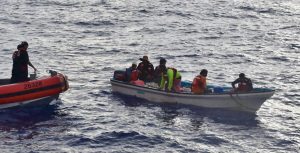Six Fishermen Saved by Personal Locator Beacon
 A group of fishermen stranded in the remote Western Pacific were recently rescued, thanks in large part to a personal locator beacon they had with them, according to a U.S. Coast Guard search coordinator.
A group of fishermen stranded in the remote Western Pacific were recently rescued, thanks in large part to a personal locator beacon they had with them, according to a U.S. Coast Guard search coordinator.
According to a news release from the U.S. Coast Guard Sector Guam, the six fishermen became stranded about 30 miles north of Satawal Atoll in the Caroline Islands when their engine failed at approximately 9 a.m. on August 17, 2024. The fishermen activated a personal locator beacon (PLB), sending a distress signal that transmitted their location to the Joint Rescue Sub-Center Guam, over 430 miles away.
The distress signal was relayed to the USCGC OLIVER HENRY, which was on patrol approximately 270 miles northeast of the fishermen, as well as the Panamanian-flagged cargo vessel ZHONG YU MARINE, a 97-meter cargo vessel located about 160 miles north of the stranded boat. Despite challenging conditions, including the remote location, thunderstorms, and low visibility, both ships reached the search area by 3 a.m. on August 18, 2024. The distressed fishing vessel was located, then towed to a nearby atoll.
“This operation underscores the vital importance of Personal Locator Beacons in maritime safety. By quickly alerting us to the fishermens’ location; the PLB effectively took the ‘search’ out of ‘search and rescue’ by narrowing the search area significantly and allowing us to focus on the swift recovery of the vessel. This highlights the strength of our regional partnerships and the profound impact of technology in enhancing our mission effectiveness.” said Cmdr. Patton Epperson, the search and rescue mission coordinator on the case, highlighting the collaborative nature of the mission.
“While the U.S. Navy P-8 Poseidon airplane and crew out of Kadena Air Force Base was en route to assist, the fishermen were located prior to their arrival. We deeply appreciate the readiness and support offered by our Department of Defense partners, which plays a crucial role in the success of our search and rescue missions,” said Epperson. “The swift response from our AMVER partner vessel, ZHONG YU MARINE, and the seamless integration of their efforts with the Coast Guard showcases our ability to overcome challenges in this expansive and remote area of Blue Pacific.”
The U.S. Coast Guard regards PLBs as essential safety equipment. These devices fall under a larger category of emergency beacons that operate at 406 megahertz, a frequency monitored by the National Oceanic and Atmospheric Administration (NOAA) and utilized in collaboration with multiple countries and organizations. PLBs are designed for individual use and must be activated manually in emergencies. Other types of beacons include the emergency position-indicating radio beacon (EPIRB), which is used on maritime vessels, and the emergency locator transmitter (ELT), found on aircrafts.
NOAA reports that the COSPAS-SARSAT satellite system, which supports personal locator beacons, has been credited with saving over 84,000 lives since its inception in 1982. In the United States alone, more than 10,000 individuals have been rescued thanks to this technology. According to NOAA, last year alone over 350 people in the U.S. activated the locator system in emergency situations. While the U.S. Coast Guard does not endorse specific brands or models of beacons, it advises selecting devices that are properly registered and meet the guidelines established by the Federal Communications Commission and NOAA.
 Maritime Injury Law Blog
Maritime Injury Law Blog

